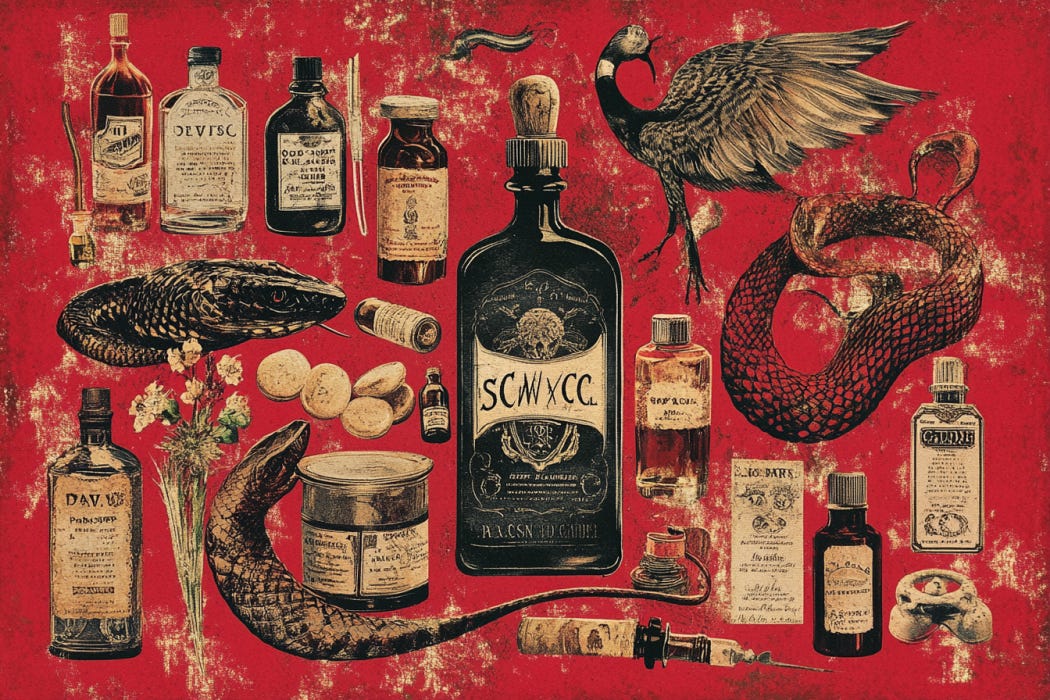One thing jumped out at me when Truemed co-founder Calley Means recently appeared on Tucker Carlson’s podcast: his demonization of the Flexner Report. He argues this point often, as evidenced by an appearance on The Model Health Show:
The medical system exists today under the Flexner Report, a report written in 1909. And it was written by a lawyer, Flexner was a lawyer for John D. Rockefeller. John D. Rockefeller paid this guy. He lobbied to get him in front of Congress and this lawyer wrote the report for modern medicine, and it said disease has to be siloed ,and we have an evidence-based situation where we silo disease and have a specific recommendation, a specific pharmaceutical treatment, a specific Intervention for that specific named condition.
This was not intuitive. The economic rationale behind that is that John D Rockefeller was the father of the modern pharmaceutical industry from byproducts of oil exploration, and he was the chief funder and propagator of modern medical schools. He was a lead donor to Johns Hopkins and other east coast medical schools that he wanted to basically propagate and solidify this serious medicine with surgeons and the kind of medicine we know today. He denigrated any type of nutrition. He denigrated any type of holistic thinking. He denigrated every other medical modality.
A lot to unpack. Means is extrapolating from some credible information and running wild with it. He’s also just making some shit up. Or, didn’t bother to actually do his research.
My guess: a nefarious oil magnate ramming pharmaceuticals down our throats serves as Goliath in Means’s narrative, which resolves with the underdog sling shooter, Small Wellness, defeating Big Medicine. It’s a compelling historical twist when you run a company that funnels pre-tax medical expense dollars into unproven and untested modalities like supplements, ice baths, and red light therapy.
Right off the top: Abraham Flexner was not a lawyer. He earned a B.A. in Classics in 1886 and studied psychology at Harvard and the University of Berlin, yet never completed an advanced degree. His report, widely known as the Flexner Report, was published in 1910, and was sponsored by the Carnegie Foundation—the official name was the Carnegie Foundation Bulletin Number Four. His main interest was in medical education reform.
Means takes no issue with rewriting Flexner’s bio and goals, however: a lawyer is much more mustache-twisting than an educator. The problem, as Paul Starr writes in his 1982 opus, The Social Transformation of American Medicine, is that “Flexner himself had an aristocratic disdain for things commercial.”
While Flexner’s report has been rightfully criticized for introducing policies that inspired systemic racism and sexism—his adherence to standards overlooked economic and gender divides—Means leaves out a ton of context in his criticisms of Flexner, and of Rockefeller: while the oil magnate funded medical reform initiatives, and invested in pharmaceuticals, there’s no evidence that his products directly led to the creation of drugs or that he was tinkering with Bunsen burners and beakers in the laboratory.
Means is engaging with common hyperbole in the modern wellness industry: all forms of healing outside of evidence-based medicine was intentionally rooted out so that doctors could push drugs.
This claim is completely fabricated.
The rise of organized medicine
19th century America was truly the Wild West when it comes to medicine. While medical schools first became a reality in Philadelphia in 1765, it took well over a century for the consolidation of curriculums to define the training and role of doctors.
Throughout most of the 19th century, doctors were not exactly respected members of society. That took a lot of time, training, and regulations to manifest. Early doctors were trained as apprentices and had to fight for business. Most could only see a handful of patients since they relied on horses to get around; the “house call” only ended a few decades after the invention of the car, when medical offices and hospitals also consolidated.
This left a lot of room for other modalities to compete. In fact, throughout most of the 19th century, homeopathy and Eclectic medicine were on par with anything in the burgeoning hospital system—unlike today, hospitals were almost exclusively for the poor, homeless, and mentally unstable.
At the turn of the 20th century, there were 22 homeopathic colleges and 15,000 practitioners in America. The Flexner Report didn’t end its reign. It was homeopathy itself. (The same is true with Eclectic medicine and osteopathy, which also reached a peak in the late 19th and early 20th centuries.)
As Starr writes, the reason these modalities suffered is due to the fact that public health protocols were being widely implemented, to great success.
While regular medicine was producing important and demonstrable scientific advances, homeopathy generated no new discoveries. The contrast was not lost on many in the group. They edged further away from [homeopathy founder] Hahnemann; the final dissolution came of itself. The Eclectics also succumbed to quite co-optation; they were only too glad to be welcomed into the fold.
That fold was organized medicine, which is what Flexner was charged to investigate. While the American Medical Association (AMA) was founded in 1847, it was just starting to get its footing in the early 1900s. Up to this point, colleges were constantly undercutting one another to graduate doctors as quickly as possible. If one college offered a three-year program, a nearby school would recruit students by offering a two-year program.
The AMA wanted standardized guidelines. In 1904, it created the Council on Medical Education (CME), which quickly landed on two standards for training doctors:
A minimum education before entering medical school
A curriculum that required two years of training in anatomy and physiology, followed by two years of clinical work in a teaching hospital
Like Rockefeller, Andrew Carnegie had an interest in raising educational standards in American medicine. His organization, Carnegie Foundation for the Advancement of Teaching, contracted with the CME in 1908. They tasked Flexner with visiting 155 medical schools in the US and Canada to ensure they were keeping up with the rather lax licensing standards of the time.
Turns out, many weren’t.
The schools were condemned primarily by the changes in licensing rather than by Bulletin Number Four. At most, Flexner hastened the schools to their graves and deprived them of mourners. He himself recognized the primacy of economic considerations. Nearly half of the medical schools, he reported, had an annual income below $10,000; their existence was precarious. They were unable to comply, he wrote, “even in a perfunctory manner with statutory, not to say scientific, requirements and show a profit.” The schools were at the end of their tether; at that point, it was relatively easy to strangle them.
Ironically (and thankfully), the AMA didn’t go as far as Flexner suggested. He believed only 31 schools passed regulatory muster. Sixty-six survived, however. Such a sudden consolidation would have resulted in medical deserts, with entire states missing training facilities. Congress mandated that at least one institution remained in each state.
Standards set by the AMA at the turn of the 20th century, which Flexner helped enforce, became the basis for modern medical training. Both Rockefeller and Carnegie funded these efforts, both in their interests in seeing education and science prosper in America, and in their own financial self-interests.
While it is true that Flexner didn’t care for non-evidence-based medicine, what didn’t happen is a strangling of “alternative” and “holistic” practitioners. Public health measures, vaccines, and the burgeoning field of pharmacology did that.
When Americans experienced the positive health benefits of better sanitation, vaccination, and antibiotics, they quickly understood they were being sold false goods by homeopaths (a number of whom, it should be noted, rejected Hanhemann’s premise and became fans of the demonized “allopathic” medicine).
Other modalities, such as chiropractic, osteopathy, naturopathy, and electromagnetic field therapy also dissolved in the public imagination during this time, with each one assimilating into modern medicine in some capacity or disappearing—albeit briefly, since the 1960s saw a resurgence in these fields.
Sadly, a good narrative is not beholden to the rigors of history in modern wellness. It’s easy to demonize long-forgotten characters who aren’t remembered fondly in the zeitgeist.
We don’t need to lionize Rockefeller, Carnegie, or Flexner, but we should be at least be honest with what they did (and did not) do. There are plenty of reasons to criticize all three men. What Calley Means is doing, however, doesn’t provide the proper context to do so—because it’s in his self-interest not to.






